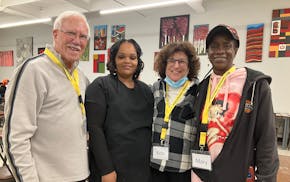In an eight-show week, producer Ken Davenport can sell 1,200 seats at his eponymous theater a few blocks off Times Square. If everyone loves the show, he gets a little word-of-mouth buzz. But he and his fellow off-Broadway producers face an eternal battle in New York.
"We're like the kid brother trying to get attention in a market that is inclined toward Broadway," he said.
So Davenport got creative last fall with a show that he felt deserved a wider audience. On Dec. 10, he live-streamed a performance of "Daddy Long Legs: The Musical." More than 150,000 people in 135 countries saw the show.
"I needed a steroid shot of word of mouth, and in one night I got the equivalent of three years of sold-out audiences," he said.
Mind you, he didn't sell 150,000 tickets, but he achieved a new level of awareness for the production — and he brought live theater to audiences who otherwise would never see it.
The flat screen, long considered theater's enemy, is exponentially expanding opportunities for fans of live performance. It can range from the sophisticated HD simulcasts of the Metropolitan Opera to dreadful YouTube representations of a high-gloss musical. (Don't get too excited when you see the little box on YouTube promising "A Chorus Line," original Broadway cast.)
If someone is curious about a particular show, it has never been easier to dial in — whether in a jammed movie house or alone online.
"What I find interesting and edifying is that I got to see 'The Curious Incident of the Dog in the Night-Time' and 'A View From the Bridge' — things I never would have seen — for 15 to 20 bucks," said Minneapolis director Jon Cranney, who saw both shows through Britain's National Theatre "NT Live" filmcasts.
It's gotten so much better
Cranney's first experiences with live theater on the screen came when he was artistic director at Children's Theatre Company in Minneapolis in the 1980s. Cable TV was desperate for programming (how else do you explain "Rich Little's Christmas Carol"?), so CTC allowed four productions to be taped.
They were very unsatisfying. It wasn't until he started going to Met simulcasts that Cranney had his "Aha!" moment.
"I came out afterward and said, 'This is indeed something new under the sun,' " he said. "The experience was large enough; the screen and the sound was big, and it was technically professional."
The Met's program is in its 10th year, with simulcasts going to 2,000 theaters in 70 countries. Shot with multiple cameras, close-ups and superior sound fidelity, the productions even include extras such as backstage intermission interviews with the stars.
Twin Cities area audiences regularly pack theaters to see the operas on Saturday afternoons. Casey Quinn of Eden Prairie, a fan since 2007, scrambled between two locations to get good seats for "Madama Butterfly" on April 2. She loves going to the Met in New York but, like a football fan who can't get to the stadium, finds the simulcasts to be in some ways superior.
"You're in the balcony at the Met; you've paid $200, and sometimes you can't tell who's singing," Quinn said. "On the screen, you can see their freckles."
Theater and opera on screen (or online) has a second benefit, she said — education. "I have learned so many operas that I would never have."
The Met and such websites as BroadwayHD.com and DigitalTheatre.com also offer streaming video to home TVs or personal devices, although the impact obviously is less than it is on the big screen. "There's a sense of energy in the room at those Met broadcasts," Cranney said. "You don't get that in your living room even in high-quality equipment. It's a scale thing."
While PBS has for years shown films produced from live productions — including the Guthrie's "HMS Pinafore" in 2011 — the television enterprise took an important step into the future with "Grease Live!" in January. Critics praised the Fox broadcast as a seminal moment in the evolution of the live-TV musical. (NBC has shown three, and has plans for a fourth, "Hairspray," in December. NBC will also show a live performance of "A Few Good Men" early next year.)
The show reached 12.2 million viewers — the equivalent of 16 years of sold-out performances of the Broadway phenom, "Hamilton."
Is it live, or something less?
Left unsaid in all this is the purity of the live theater performance — the irreplaceable experience of being in the same room with performers who are sweating and shouting in three-dimensional humanity.
Maybe no one knows that better than Davenport. He sat in the theater lobby and watched the live stream of "Daddy Long Legs" last December. Every 10 minutes or so, he'd get up and walk into the theater just to experience the different buzz.
"It was like the difference between mono sound and stereo," he said. "This wave of sound and color you get is so different. I don't think the live experience will ever be outdated."
Still, streaming video can at least whet the appetite.
"I remember when I was a kid growing up in suburban Massachusetts, I watched the Red Sox games in my living room and I'd see Fenway Park and hear about the Green Monster and I'd think, 'I really want to go there. I want to be in that room.' "
Graydon Royce • 612-673-7299 Twitter: @graydonroyce

Minnesota veteran makes 1,000-mile 'gratitude walk' for program that helps vets

At 90, Minneapolis volunteer has lifetime of service

Betting on Uptown
